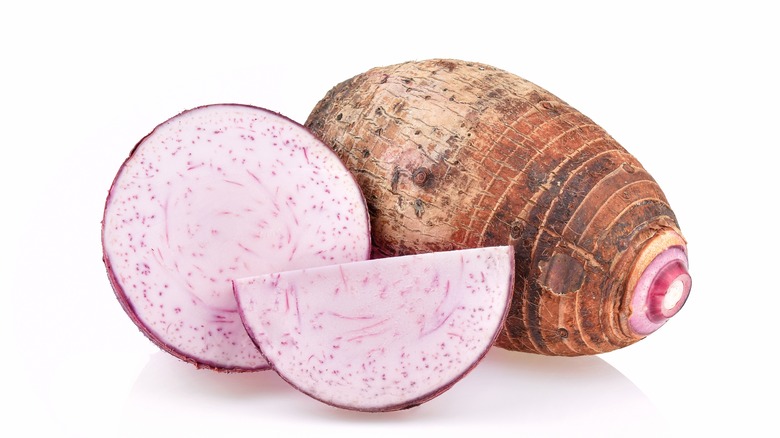
Taro: What is the benefit of eating taro?
အောက်ဆုံးထိ ဆွဲကြည့်ပေးကြပါ ခင်ဗျာ
Taro root tastes mildly sweet and is chock-full of nutrients. You can find fiber, potassium, magnesium, and many other vitamins and minerals in this vegetable.
Taro root is a boring root vegetable initially developed in Asia however presently delighted in around the world.
It has white flesh with purple specks all over and brown outer skin. When cooked, it has a somewhat sweet taste and a surface like potato.
Taro root is an incredible wellspring of fiber and different supplements and offers an assortment of potential medical advantages, including further developed glucose the board, stomach and heart wellbeing.
The following are 7 medical advantages of taro root.
1. Rich in Fiber and Other Important Nutrients
One cup (132 grams) of cooked taro has 187 calories — mostly from carbs — and fewer than one gram each of protein and fat (1).
It also contains the following:
- Fiber: 6.7 grams
- Manganese: 30% of the daily
value (DV) - Vitamin B6: 22% of the DV
- Vitamin E: 19% of the DV
- Potassium: 18% of the DV
- Copper: 13% of the DV
- Vitamin C: 11% of the DV
- Phosphorus: 10% of the DV
- Magnesium: 10% of the DV
Thus, taro root has good amounts of various nutrients that people often don’t get enough of, such as fiber, potassium, magnesium and vitamins C and E.
2. May Help Control Blood Sugar
Although taro root is a starchy vegetable, it contains two types of carbohydrates that are beneficial for blood sugar management: fiber and resistant starch.
Fiber is a carbohydrate that humans can’t digest. Since it’s not absorbed, it has no impact on blood sugar levels.
It also helps slow down the digestion and absorption of other carbs, preventing large blood sugar spikes after meals.
Studies have found that high-fiber diets — containing up to 42 grams per day — can reduce blood sugar levels by roughly 10 mg/dl in people with type 2 diabetes.
Taro also contains a special type of starch, known as resistant starch, that humans cannot digest and thus does not raise blood sugar levels. Roughly 12% of the starch in cooked taro root is resistant starch, making it one of the better sources of this nutrient.
This combination of resistant starch and fiber makes taro root a good carb option — especially for people with diabetes.
3. May Reduce Your Risk of Heart Disease
The fiber and resistant starch in taro root may also help reduce your risk of heart disease.
Substantial research has found that people who eat more fiber tend to have lower rates of heart disease.
One study found that for every additional 10 grams of fiber consumed per day, the risk of dying from heart disease decreased by 17%.
This is believed to be due in part to fiber’s cholesterol-lowering effects, but research is ongoing.
Taro root contains more than 6 grams of fiber per cup (132 grams) — more than twice the amount found in a comparable 138-gram serving of potatoes — making it an excellent source of fiber.
Taro root also provides resistant starch, which lowers cholesterol and has been linked to a reduced risk of heart disease.
4. May Offer Anticancer Properties
Taro root contains plant-based compounds called polyphenols that have different medical advantages, including the possibility to decrease disease risk.
The principal polyphenol found in taro root is quercetin, which likewise exists in huge sums in onions, apples and tea.
Test-cylinder and creature investigations have discovered that quercetin can set off disease cell demise and slow the development of a few kinds of malignant growths.
Likewise a strong cell reinforcement shields your body from unreasonable free extreme harm that has been connected to disease .
One test-tube investigation discovered that taro separate had the option to stop the spread of certain sorts of bosom and prostate disease cells, however no human examination has been led.
While early investigations are promising, more examination is expected to all the more likely figure out the anticancer properties of taro.
5. May Help You Lose Weight
Taro root is a good source of fiber, containing 6.7 grams per cup (132 grams).
Research has found that people who eat more fiber tend to have lower body weight and less body fat.
This may be because fiber slows stomach emptying, which keeps you fuller longer and reduces the number of calories you eat throughout the day. Over time, this may lead to weight loss.
The resistant starch in taro root may have similar effects.
One study found that men who took a supplement containing 24 grams of resistant starch before meals consumed roughly 6% fewer calories and had lower insulin levels after the meal, compared to the control group.
Animal studies have also shown that rats fed diets high in resistant starch had less total body fat and belly fat. It’s hypothesized that this is partially due to resistant starch increasing fat-burning in your body, but further research is needed.
6. Good for Your Gut

Since taro root contains plenty of fiber and resistant starch, it may be beneficial to gut health.
Your body does not digest or absorb fiber and resistant starch, so they remain in your intestines. When they reach your colon, they become food for the microbes in your gut and promote the growth of good bacteria.
When your gut bacteria ferment these fibers, they create short-chain fatty acids that nourish the cells that line your intestines and keep them healthy and strong.
One study in pigs found that diets rich in resistant starch improved colon health by boosting short-chain fatty acid production and decreasing damage to colon cells.
Interestingly, human studies have found that people with inflammatory intestinal disorders, such as ulcerative colitis, tend to have lower levels of short-chain fatty acids in their guts.
Some research suggests that consuming fiber and resistant starch can boost these levels and help protect against inflammatory bowel disease and colon cancer.
7. Versatile and Easy to Add to Your Diet
Taro root has a starchy texture and mild, slightly sweet taste, similar to sweet potato. It can be used in both sweet and savory dishes.
Some popular ways to enjoy it include:
Taro chips: Thinly slice
taro and bake or fry into chips.
Hawaiian poi: Steam and mash
taro into a purple-hued puree.
Taro tea: Blend taro or
use taro powder in boba tea for a beautiful purple drink.
Taro buns: Bake sweetened
taro paste inside buttery pastry dough for dessert.
Taro cakes: Mix cooked taro
with seasonings and pan fry until crispy.
In soups and stews: Cut taro into chunks and use in
brothy dishes.
It’s important to note that taro root should only be eaten cooked.
Raw taro contains proteases and oxalates that can cause a stinging or burning sensation in your mouth. Cooking deactivates these compounds.
- What is the message of the song “Imagine” by John Lennon brainly?

- What is the mean of Wind of Change ?

- The Key Vitamin That Prevents Dementia

- Coffee May Help Protect Against AFib, Challenging Advice to Avoid It
- What Is The Difference Between Being Hard of Hearing and Deaf?

- What is Respiratory syncytial virus?



Can I just say what a relief to seek out somebody who really knows what theyre speaking about on the internet. You positively know methods to deliver a difficulty to gentle and make it important. Extra folks have to read this and perceive this facet of the story. I cant believe youre no more standard because you undoubtedly have the gift.
Thanks for posting. I really enjoyed reading it, especially because it addressed my problem. http://www.ifashionstyles.com It helped me a lot and I hope it will help others too.
ကျေးဇူးတင်ပါတယ်
Good morning all guys ❤️🌅
ဝေးခဲ့ပြီ😥😥😥
Oh my goodness! a tremendous article dude. Thank you Nevertheless I’m experiencing issue with ur rss . Don抰 know why Unable to subscribe to it. Is there anyone getting similar rss problem? Anyone who knows kindly respond. Thnkx
Done ✅
Hi I am so grateful I found your webpage, I really found you by accident, while I was researching on Yahoo for something else, Anyhow I am here now and would just like to say many thanks for a fantastic post and a all round thrilling blog (I also love the theme/design), I don抰 have time to browse it all at the minute but I have bookmarked it and also added in your RSS feeds, so when I have time I will be back to read a lot more, Please do keep up the excellent work.
I want to thank you for your assistance and this post. It’s been great.
Please tell me more about your excellent articles
You’ve been great to me. Thank you!
I like the snacks made with taro.
Very good 👍🥰
It is very tasty when cooked with shrimp.🦐🦐🦐🥗
🖤🖤
Taro is my favorite food. Thanks for your intersting article and nice song 🤗💌
Thanks lots for knowledge and good song 🎵
❤
Taro..is one of my favourite foods. Thanks lots to know about taro .
Thanks your C4a team.🫰🫰🫰❤️❤️❤️
သံဇဉ် နဲ့ သာယာနေတာ 😍
Good.
Thanks
Thanks ❤️
Thanks for sharing ❤️
I like taro very much. Thanks lots for article and good song 🎵
Thanks
Much appreciated!
Very good article
I like the song ❣️❤️❤️
Thank you so much for kindness sharing and your efforts. Be healthy, Guys!